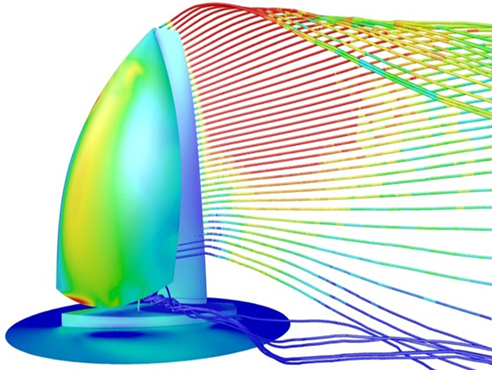
ANSYS FLUENT uses computational fluid dynamics (CFD) numerical simulation techniques to provide solutions to fluid problems for engineers in various industries worldwide. FLUENT's rich physical models make it widely applicable: from aircraft aerodynamics to boiler combustion, from bubble towers to glass manufacturing, from blood flow to semiconductor production, from cleanroom to wastewater treatment plant design, and more. In addition, the powerful simulation capabilities of the software have expanded its applications in fields such as rotating machinery, aerodynamic noise, internal combustion engines, and multiphase flow systems.

FLUENT can be customized or fully integrated with ANSYS Wrokbench, and allows users to adjust the integration functions appropriately, easily and quickly solving some special challenges. The ANSYS Workbench platform can be directly coupled with CAD software to automatically extract fluid calculation domains and partition grids, easily obtaining high-quality grids to meet the precise and fast requirements of CFD simulation.

The FLUENT software package contains solvers that can accurately simulate various engineering flow problems encountered in daily life, from Newtonian fluids to non Newtonian fluids, from single-phase flow to multiphase flow, from subsonic to hypersonic. Each solver has extremely high robustness, has undergone thorough testing and validation, and has been optimized to save simulation time. After time verification, the efficient solver in a unified environment has demonstrated high accuracy and speed.

For a deeper understanding, the calculation accuracy can be improved by increasing the refinement level of the analysis grid. Therefore, more computing resources and parallel computing are needed. Fluent has outstanding parallel scalability and acceleration ratio for parallel computing ranging from two cores to thousands of cores, providing high-precision computing results in the shortest possible time.

CAD import and meshing
From CAD import to geometric meshing, flexible tools allow users to automatically create meshes or manually generate them. ANSYS mesh partitioning can extract fluid computational domain space from CAD assemblies and automatically generate tetrahedral or hexahedral plus boundary layer meshes. Meanwhile, advanced repair tools allow users to import and preprocess geometry, manually generating partial or overall meshes.

Quickly extract fluid calculation domain space from CAD assembly and partition it into grids

Fluent provides various forms of advanced turbulence models, including algebraic, one equation, two equation, and Reynolds stress models

Advanced chemical reaction flow models can solve combustion problems of various gaseous, coal, and liquid fuels

Using multiphase flow model to solve performance problems of separation equipment

Aeroacoustic simulation of NACA 0012 airfoil trailing edge noise
Advanced physics model functionality
turbulence model
A wide range of model systems, providing leading turbulence simulation capabilities. This includes several popular versions of the k-epsilon and k-omega models, as well as the Reynolds stress model suitable for highly anisotropic flows. It also provides advanced scale turbulence models, including Large Eddy Simulation (LES), Separated Eddy Simulation (DES), and Adaptive Eddy Simulation (SAS). The transition model (SST) can accurately predict the transition of boundary layer flow from laminar to turbulent state.
Robust solver
Fluent includes a coupled solver for pressure basis, a separated solver for pressure basis, and two density basis solvers, implicit and explicit. No matter what problem you are studying, ANSYS has a solver that suits your needs. The default values of the new version of the intelligent solver make the solution more robust; Enhanced the robustness of the dynamic grid; Improved numerical methods to make the solution more robust.
Chemical reaction flow
The comprehensive chemical reaction flow simulation function allows users to simulate gaseous reactions using simple or complex chemical reactions. The embedded pollutant model is simple and easy to use, and can accurately predict the emissions of pollutants such as NO, SO, and soot. At the same time, simulation of surface chemical reactions can also be conducted. All chemical reaction models and turbulence models are compatible.
Multiphase flow
Rich multiphase flow models are used to simulate the states and interactions of many phases during mixing, including liquid, solid, gas, and particle flows, by using mixed fraction models or Euler models; Using VOF model to track multiple immiscible fluids; Use discrete phase models to handle problems such as particle and droplet fragmentation and evaporation. Software can also simulate phase transitions.
Other advanced features
Advanced acoustic simulation functions, such as the Ffowcs Williams Hawkings acoustic analogy method and the ability to directly calculate aerodynamic noise, can be used to simulate the propagation of aerodynamic noise. The dynamic/mobile grid function allows you to simulate flow problems related to moving parts.
Integrated functions
Parallel scalability
The parallel extension function ensures that simulations can efficiently utilize parallel networks composed of processors of the same or different classes. Dynamic, physics based load balancing technology automatically detects and analyzes parallel performance, adjusts the distribution of computing grids between different processors, and maximizes computing speed.
User customization
Implement user-defined professional physical models, design and script user environments for better operational experience, and further automate workflows.
Design exploration and optimization
In order to increase the throughput of simulation, Fluent allows for automated study of multiple parameterized design variables without the need for other programs. The ANSYS integrated experimental design solution enables users to easily analyze thousands of data points in the same user environment.
ANSYS Fluent is the first commercial CFD code to provide innovative adjoint matrix solver technology. Due to its ability to estimate the impact of parameter changes on the overall system performance before actual modifications are made, the accompanying matrix solver further improves simulation speed and, more importantly, contributes to innovation.

Simulation of Temperature Control in Data Centers

Aerodynamic simulation of sailboat model, with over 1 million computational grids, solved using HPC functionality

Using Euler particle model to simulate the influence of hardware components on droplet and catalyst distribution in fluidized catalytic cracking unit